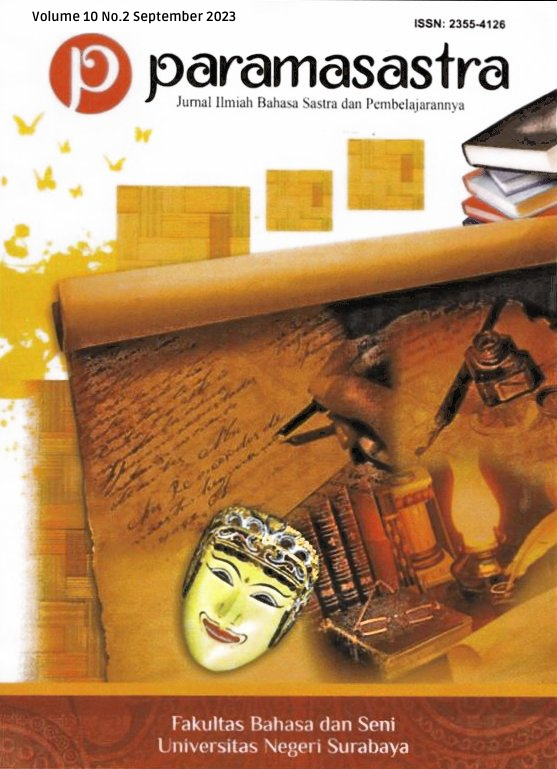MAKNA SEMIOTIK TAYANGAN IKLAN AQUA EDISI “NGOMONG JEPANG” PADA MEDIA TELEVISI
DOI:
https://doi.org/10.26740/paramasastra.v10n2.p288-299Abstract
This research is motivated by the delivery of messages and meanings in the "Ngomong Jepang" edition of Aqua advertisements that are not conveyed in full. That way, the focus of this study, the researcher seeks to explore the messages and meanings of Aqua's "Ngomong Jepang" edition. The research method used is a descriptive research method with a qualitative approach that uses a critical paradigm. The data collection techniques in this research are literature study, documentation and interpretation. Then it can be concluded that there are 3 different meanings through Barthes' semiotic analysis contained in the "Ngomong Japan" edition of the Aqua advertisement, namely the denotative meaning, containing the incident of one of the staff welcoming delegates from Japan who failed to focus in the midst of carrying out his duties. The connotative meaning, contains the miss perception of one of the staff welcoming delegates from Japan due to mild dehydration. The mythical meaning is that a person will not focus on his work if he has not consumed Aqua mineral water. In addition, the Aqua brand is a mineral water brand that is widely recognized, even by hotel staff. This means that whatever the need for mineral water that sticks in people's minds is the Aqua brand.
References
Djajasudarma, T. F. (2009). Semantik 1 : Makna Leksikal dan Gramatikal. Bandung: PT. Revika Aditama.
Hoed, B. H. (2014). Semiotika & Dinamika Sosial Budaya. Jakarta: Komunitas Bambu.
Jaiz, M. (2014). Dasar-Dasar Periklanan (Cetakan ke-4). Yogyakarta: Graha Ilmu.
Kusuma, P. K. N., & Nurhayati, I. K. (2019). Analisis Semiotika Roland Barthes Pada Ritual Otonan Di Bali. Jurnal Manajemen Komunikasi, 1(2), 195. https://doi.org/10.24198/jmk.v1i2.10519
Pataeda, M. (2001). Semantik Leksikal. Jakarta: Rineka Cipta.
Puteri, B. D. Y. (2017). Analisis Semiotik Pada Iklan-Iklan Aqua Di Media Televisi. Paramasastra, 4(1). https://doi.org/10.26740/parama.v4i1.1492
Riwu, A., & Pujiati, T. (2018). Analisis Semiotika Roland Barthes pada Film 3 Dara. Deiksis, 10(03), 212. https://doi.org/10.30998/deiksis.v10i03.2809
Sobur, A. (2013). Semiotika Komunikasi. Bandung: PT REMAJA ROSDAKARYA.
Wibowo, I. S. (2013). SEMIOTIKA KOMUNIKASI Aplikasi Praktis Bagi Penelitian dan Skripsi Komunikasi (2 ed.). Jakarta: Mitra Wacana Media.
Downloads
Published
How to Cite
Issue
Section
 Abstract views: 778
,
Abstract views: 778
, PDF Downloads: 234
PDF Downloads: 234












